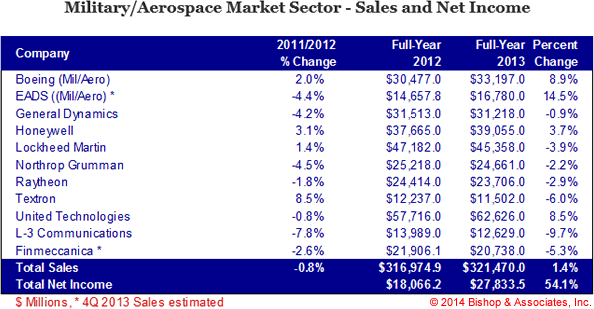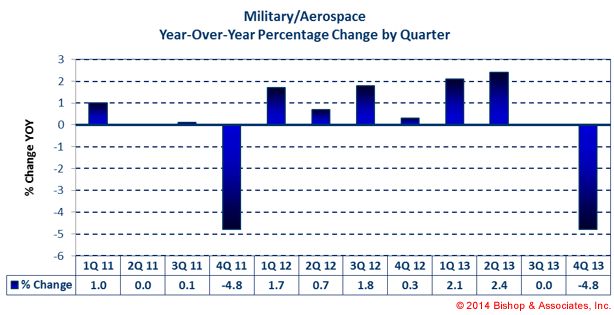The Military Market Continues to Contract
Trends in the global military/aerospace cable assembly market vary greatly by region, as they are significantly impacted by individual governments, policies, and budgets. That’s why the military market continues to contract.

Bishop tracks 11 companies in the military/aerospace market sector. Growth in the military/aerospace market, as measured by these 11 companies, has been poor in the last two years, with a year-over-year contraction of -0.8% in 2012 and growth of 1.4% in 2013. In comparison, the cable assembly market for the worldwide military/aerospace market sector contracted -4.6% year over year in 2012 and -3.1% 2013. Trends in the global military/aerospace cable assembly market vary greatly by region, as they are significantly impacted by individual governments, policies, and budgets. In general, however, the United States is the biggest producer of military hardware, with a 40% share of worldwide military spending. Significant budgets cuts, which started in 2011, are expected to continue through the end of this decade. The NATO countries in Europe, for the most part, are also expected to continue to operate at reduced levels of military spending.
Bishop follows electronic interconnects sales trends in 13 markets. The combined annual revenue of all the market sectors was $4.24 trillion in 2013 and grew 0.8% over 2012. Of the 13 market sectors, military/aerospace was the sixth-fastest growing market sector in 2013, at 1.4% year over year with combined revenues of $321.5 billion. Profitability was $27.8 billion at 8.7% of sales, making it one of the more profitable sectors.
For the full year 2013, EADS (defense) had the largest increase in sales, at 14.5% year over year to $16.8 billion. Some of EADS growth in 2013 was due to launcher and satellite businesses, the Eurofighter program, and 37 Super Puma helicopter deliveries.
Boeing (military) has the second-highest growth for 2013, with sales up 8.9% year over year to $33.2 billion. Boeing Chairman and Chief Executive Officer Jim McNerney said, “Our Defense, Space & Security unit overcame a tough operating environment to record expanded revenue, earnings, and margins while executing our commitments on the KC-46A tanker and developing and delivering important new capabilities to customers, such as the P-8 maritime aircraft and the Inmarsat-5 satellite.”
United Technologies saw its total sales grow 8.5% in 2013 to $62.6 billion. UTC sales were up across the board. 53% of the company’s sales are in commercial and military aerospace.
Honeywell’s overall sales grew 3.7% in 2013. Their aerospace business sales, which represent roughly 31% of the company, were flat to 2012.
The remaining seven companies contracted in 2013, almost all resulting from defense budget cuts. The largest contraction was with L-3 Communications. In a recent investor’s presentation, L-3 showed that 60% of its business is with the US Department of Defense (DoD). In 2013, DoD spending was down 10% from the prior year.
In 2014, Bishop will be adding a twelfth company to the military/aerospace market sector, BAE Systems. BAE is a $30 billion-plus business that grew 1.5% in 2013 in local currency, making it one of the largest defense contractors worldwide. It operates primarily in the US, UK, Saudi Arabia, and Australia.
The following table shows the results for the 11 companies we track in this market sector.

As shown in the following chart, year-over-year sales have been in the low single-digit range or negative over the last 12 quarters. Sequentially, fourth quarter 2013 sales increased 4.7% from the third quarter of 2013.

- The military/aerospace electronics market has seen significant downward changes in the last few years.The ending of the wars in Iraq and Afghanistan have significantly diminished the spending associated with these conflicts for new and replacement equipment and munitions.
- The Budget Control Act of 2011, which led to the sequester and other program cuts, has resulted in more than $85 billion eliminated from the annual defense budgets over the next several years.
- The Navy recently announced that it will significantly reduce the number of F-35 aircraft it buys.
- European countries have also significantly reduced their defense spending. The question is, have they reduced spending too much and can they still support NATO?
- Will the Japanese government increase its military spending, as it has stated? Japan has been experiencing increasing military pressure from neighboring countries, particularly China and North Korea. For this reason, it would like to increase spending. The questions is, will it? Japan has the highest debt-to-GDP ratio of all the Western countries, at 212%, so money is tight. It has also taken on the objective of significantly reducing its dependence on nuclear energy, which has very high public support and will be expensive. It is questionable that the government will have the political wherewithal to significantly increase military spending.
- From an industry standpoint, military cable assemblies still represent a good market niche with better than average returns.
Bishop & Associates projects the worldwide market for military/aerospace cable assemblies to grow 2.5% in 2014 to $13.4 billion. At 6.0% year-over-year growth, Japan will be the fastest-growing region in 2014 for this market sector.
Dave Pheteplace, VP, Bishop & Associates, Inc.
[hr]
No part of this article may be used without the permission of Bishop & Associates Inc. If you would like to receive additional news about the connector industry, register here. You may also contact us at [email protected] or by calling 630.443.2702.
- The Outlook for the Cable Assembly Industry in 2021 and Beyond - May 18, 2021
- A Data-Hungry World is Driving Demand for Wireless Connections - January 26, 2021
- Innovation and Expansion Drives Growth of Global Cable Assembly Market - May 7, 2019





